AC charging with a standardised plug-in device, for example, on a protective contact socket or CEE socket with up to 16A. There is no communication between the vehicle and the infrastructure. A residual current device (RCD) is mandatory for this charging mode.
Electromobility – the future of transport?
Climate change is already here
The increase in extreme weather events has already been noticed by many in everyday life in 2020 and 2021. For those who have experienced forest fires and floods, climate change is already a disaster. We must make use of the subsidies and options offered to us by legislators to combat climate change as much as we can. To counter greenhouse gas emissions, the Paris Agreement set an ideal limit on global warming to 1.5 °C by 2050. The European Commission is aiming for zero net greenhouse gas emissions across the EU by 2050, as per its strategy paper from 2018. The Global Climate Crisis Advisory Group, however, has already reported an average global increase in in the average temperature of 1.2 °C. In particular, the Arctic has warmed up faster than expected, with an increase of 3 °C since 1860 [6].
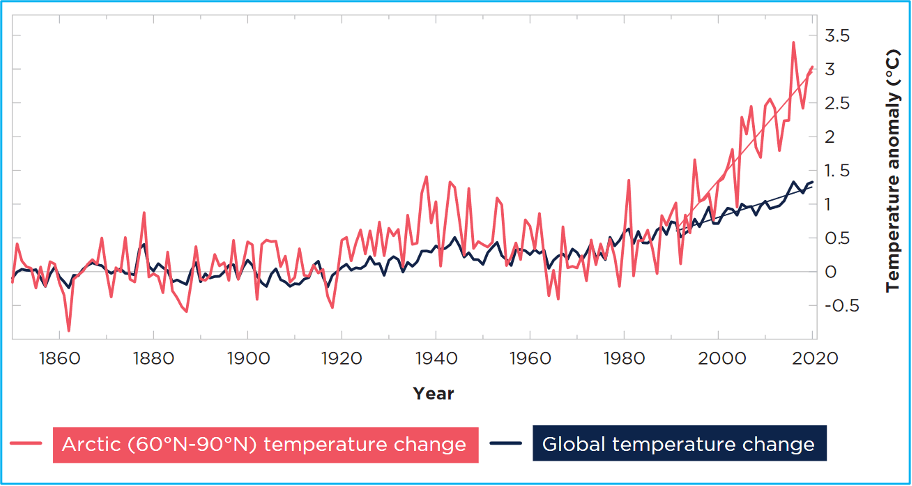
Figure 1: Strong increase in Arctic temperatures (Source: CCAG [6])
Transport accounts for almost 30 percent of the EU’s total CO2 emissions. Of this, 72 percent is road traffic alone. The EU has set itself the target of reducing transport emissions by 60 percent compared to 1990 levels by 2050 [7]. Electric transport and renewable energy sources are promising solutions.
Life cycle analyses (LCA) of electric cars show a lower CO2 footprint than conventional cars
The author of this blog has evaluated five recent studies on the “pros and cons” of electric cars. These were created by independent organisations (see source list). In all five studies, the central statement was that the sustainability, and thus the CO2footprint, of electric cars compared to conventional cars depends essentially on the proportion of green electricity used in both manufacture and driving. Expressed in kilometres travelled: an electric car, driven with a mix of coal and green electricity, only compensates for the difference in emissions from about 30,000 km, compared to a conventional car [4]. It should be noted that in the future, the proportion of green electricity in the German grid will increase - according to the German government's target, an increase to at least 65 percent is planned by 2030. Significant technological and environmental progress can also be expected in the manufacture of vehicle batteries.
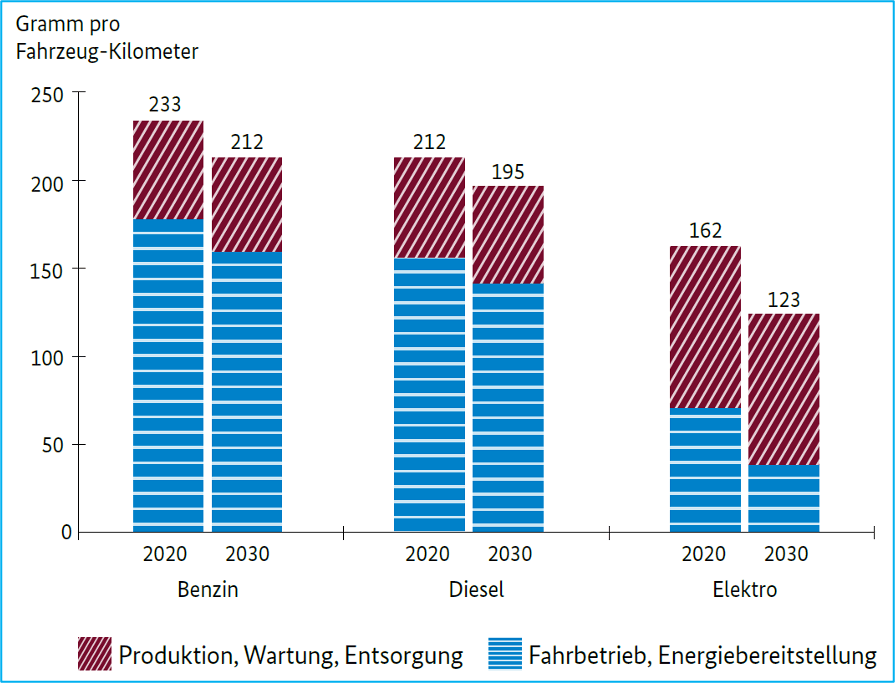
Figure 2: Carbon dioxide emissions over the entire life cycle using the example of a compact car (source: BMU [1])
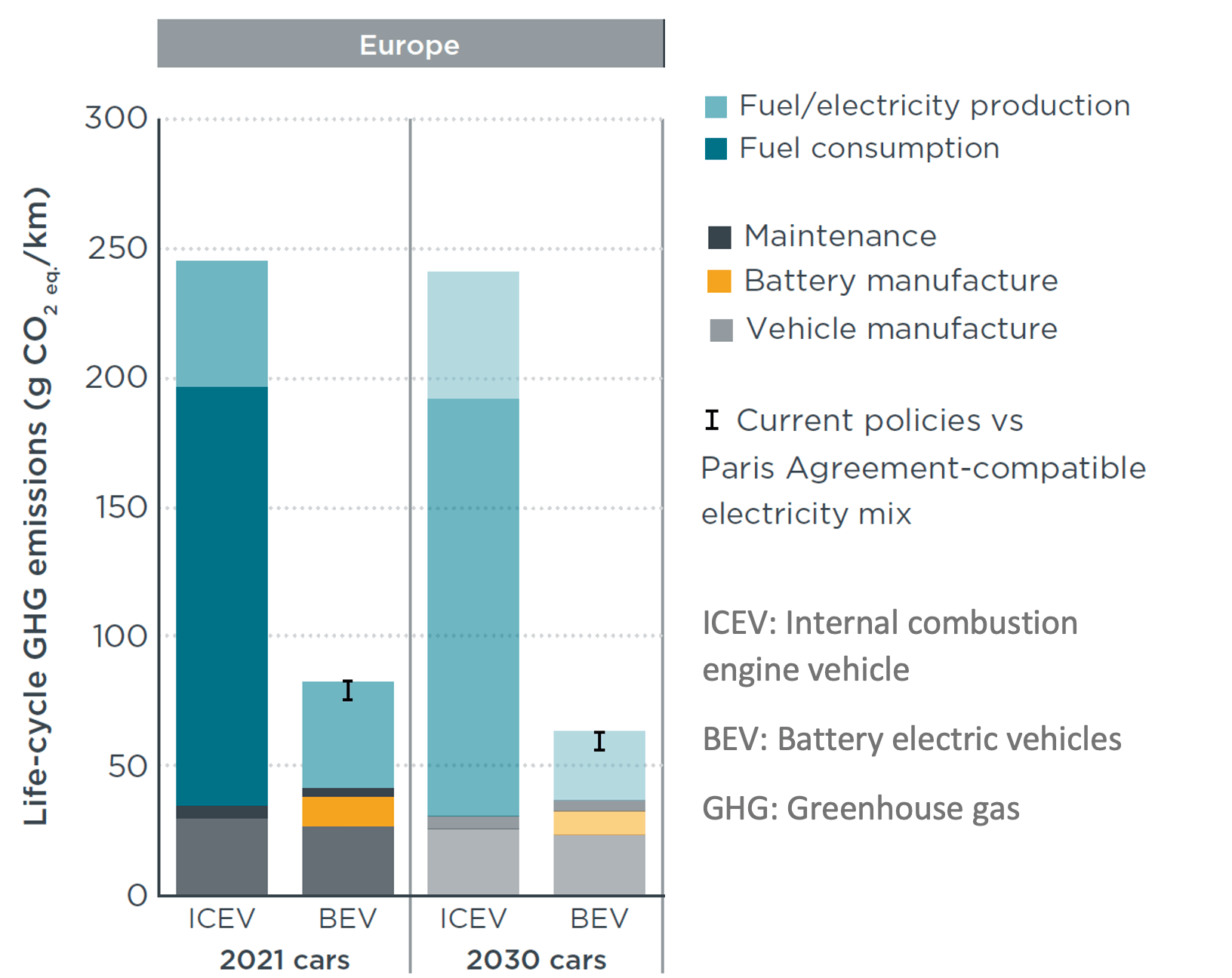
Figure 3: Greenhouse gas emissions in the life cycle of a medium-sized conventional car (ICEV) and a medium-sized battery-powered electric car (BEV) in Europe in 2021 compared to the expected emissions in 2030. The black vertical lines represent the difference between the official objectives of the European Union and those of the Paris Agreement (Source: International Council on Clean Transportation [5]).
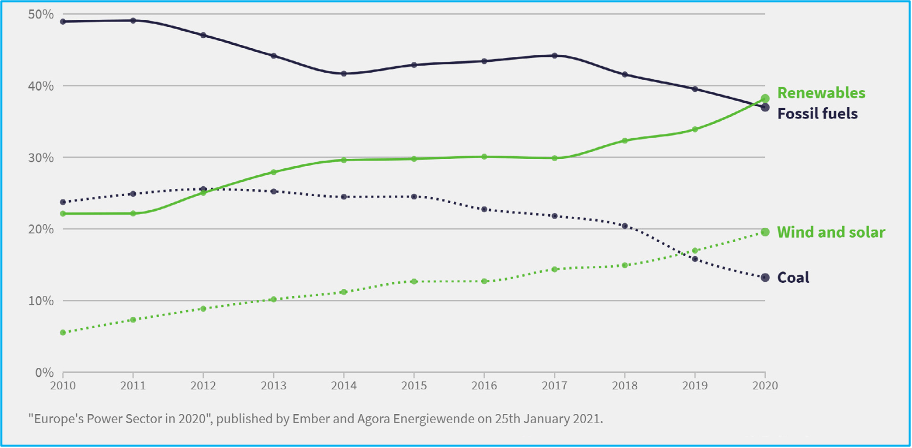
Figure 4: Sustainable energy sources already take precedence in electricity generation in Europe (source: Agora Energiewende and Ember [8])
Funding programmes for charging infrastructure
The Federal Ministry of Transport and Digital Infrastructure (BMVI) subsidises battery electric mobility based on the Electromobility Funding Guidelines. This year (2021), applications can be submitted for subsidies in the areas of electric charging points, electric vehicles and concepts. Both publicly accessible charging infrastructures for electric vehicles and private charging points will be subsidised [10].
Subsidised publicly accessible charging infrastructure
With the programme “On-site Charging Infrastructure” from 24.03.2021, the BMVI continues the previous programme. Funding should encourage small and medium-sized enterprises in particular to invest in electromobility. Applications can be submitted until 31.12.2021 [10].
The system supports normal charging points with a capacity of up to 22 kW and rapid charging points with a capacity of more than 22 kW, at which charging will only take place with a direct current (DC). The costs for associated mains connections or combinations of mains connection and buffer storage are also eligible. With the budget available, at least 50,000 charging points (of which at least 20,000 would be rapid charging points) should be established by the end of 2025 [10].
All information on the current application and authorisation procedures can be found on the Federal Institute for Administrative Services website. In addition, some federal states offer their own subsidies for charging infrastructure.
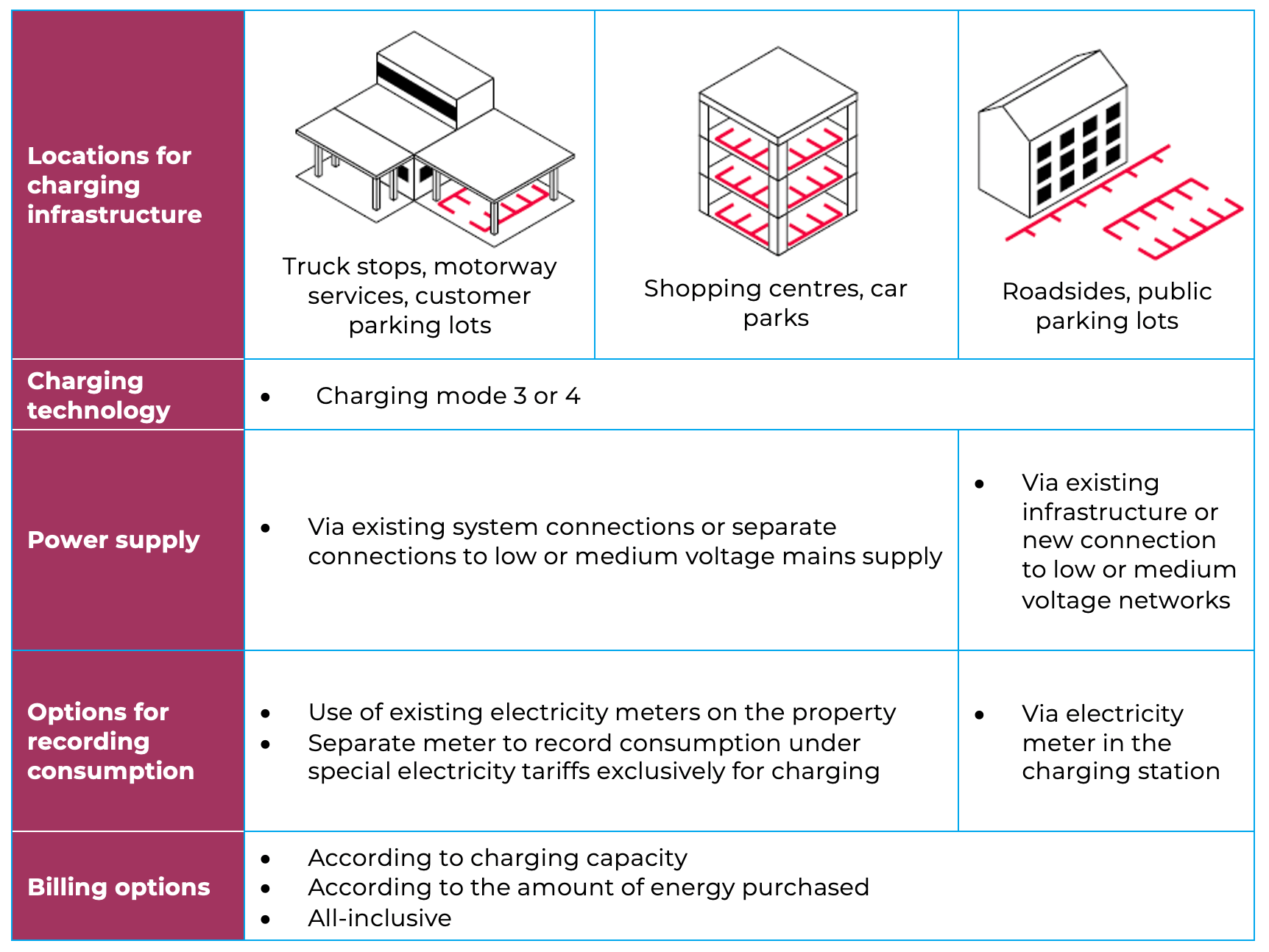
Table 1: Charging infrastructure of publicly accessible chargers
Funding for private charging infrastructure
In addition to the existing programme for subsidising electric cars , the BMVI also supports private property owners while building. Tenants, home owners and landlords can apply for 900 Euros per charging point when installing private charging stations. Companies wishing to set up charging stations for commercial use (e.g. as customer parking spaces or for loading company vehicles) are not eligible to apply.
In principle, funding is subject to the following conditions:
- The charging station must have a standard charging capacity of 11 kW.
- The charger must only use electricity from renewable energies; for example, directly from an own photovoltaic system or via the energy supplier.
- The charging station must be intelligent and controllable. This is to avoid overloading local electricity networks.
Wall boxes or charging stations will be subsidised, as well as the energy and charge management system required to control the charging stations and the electrical connection, including installation by an electrician. You can apply for the funding from KfW via the grant portal.
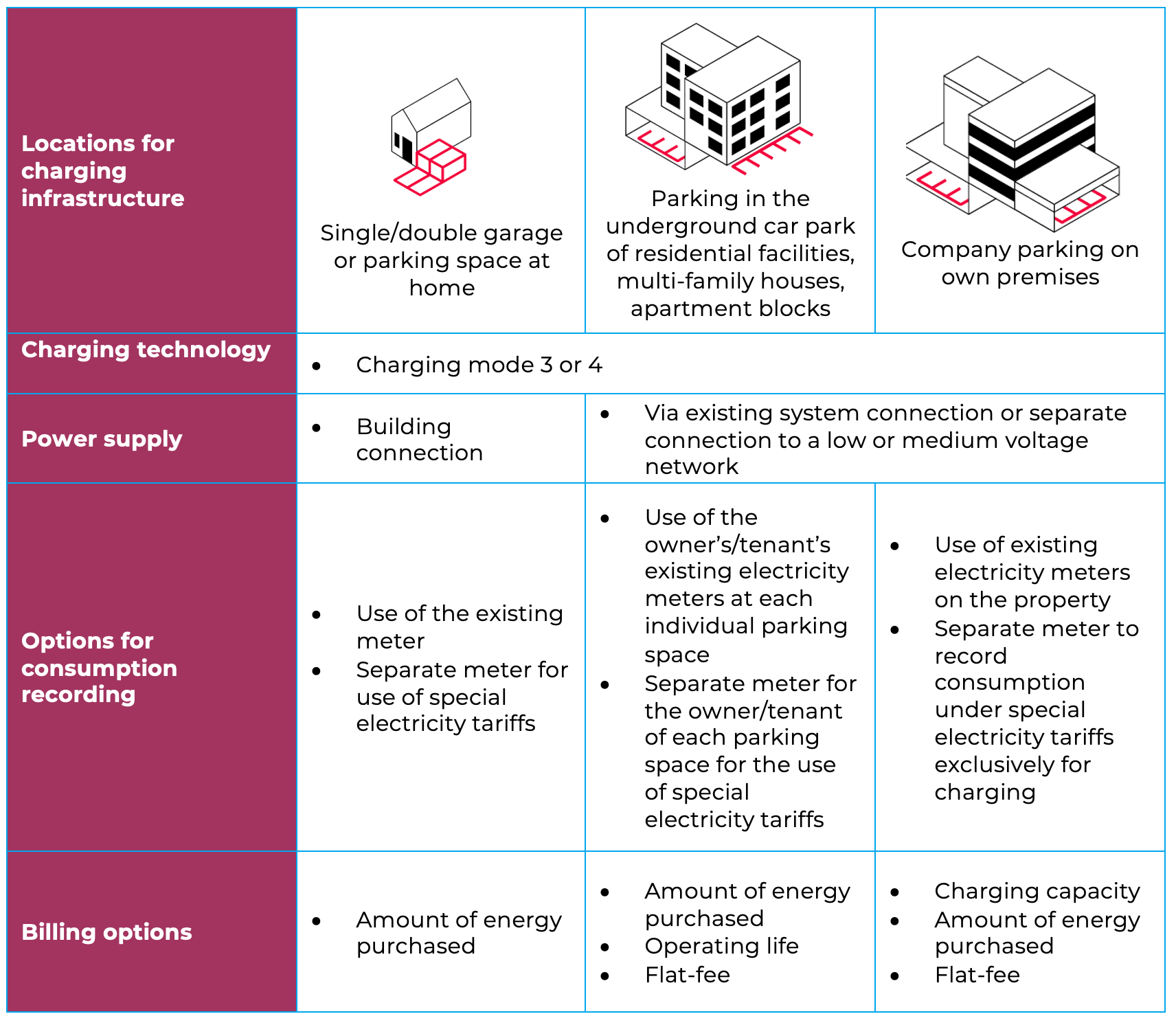
Table 2: Charging infrastructure for private loading areas
E-charging stations for Green Building certification
BREEAM
BREEAM is a widely-used British system to assess and certify ecological buildings. The “alternative means of transport” credit is one among a wide variety of credits available to evaluate a project. Depending on the system variant (new construction or inventory), points can be awarded for the installation and/or operation of e-charging stations. The condition is that electric charging stations are available for at least 3 per cent of the parking spaces. It must also be evident that the electric vehicles used have lower carbon dioxide emissions in their life cycle than conventional vehicles. Due to advances in battery technology and an improved sustainable mix of power, it is now possible to obtain the necessary data and evidence.
LEED®
LEED is a widely-used and successful American system that rewards the use of alternative vehicles in a similar way to BREEAM. The Building Design and Construction v4 (LEED BD+C v4) system variant requires that 5 per cent of the parking space capacity be made available for alternative vehicles within the scope of the “Green Vehicles" credit. These parking spaces also require a 20 per cent discount on parking fees. If the company has decided to subsidise electric vehicles, an additional 2 per cent of all parking spaces must be equipped with electric charging stations or wall boxes. The E-charging stations must be able to exchange information and must be programmable for special applications (e.g. off-peak charging).
Building Electromobility Infrastructure Act (GEIG)
In March 2021, the “German Act to Develop a Building-Integrated Charging and Connection Infrastructure for Electric Mobility" came into force. For the construction of new buildings and the renovation of residential and non-residential buildings, it requires that a minimum number of parking spaces be supplied with the technical infrastructure and/or with charging stations.
New buildings
According to GEIG, if the new residential building has more than five parking spaces, every parking space must be equipped with protective pipes for electric cables. This applies to every third parking space in the case of newly-constructed non-residential buildings with more than six parking spaces. At least one charging point must also be installed in non-residential buildings.
Renovation of existing buildings
In case of major renovation of existing residential buildings with more than ten parking spaces, all parking spaces must be equipped with protective pipes for electrical cables. In case of major renovation of existing non-residential buildings with more than ten parking spaces, one in five parking spaces must be equipped with protective pipes for electrical cables and at least one charging point must also be installed. After January 1, 2025, each non-residential building with more than 20 parking spaces will be equipped with at least one charging point.
Exceptions include non-residential buildings owned by and used primarily by small and medium-sized enterprises, and existing buildings for which the cost of charging and piping infrastructure exceeds seven per cent of the total cost of a major renovation.
Glossary
Charging point
A charging point is the location of a charging device to which a single electric vehicle is connected (see figure).
Charging Device/Wall Box/Charging Station
Charging devices are either fixed-installation sockets, suitable for charging vehicles due to their capacity to carry a continuous current or charging columns and wall boxes for installation in garages, carports or parking spaces that supply one or more charging points.
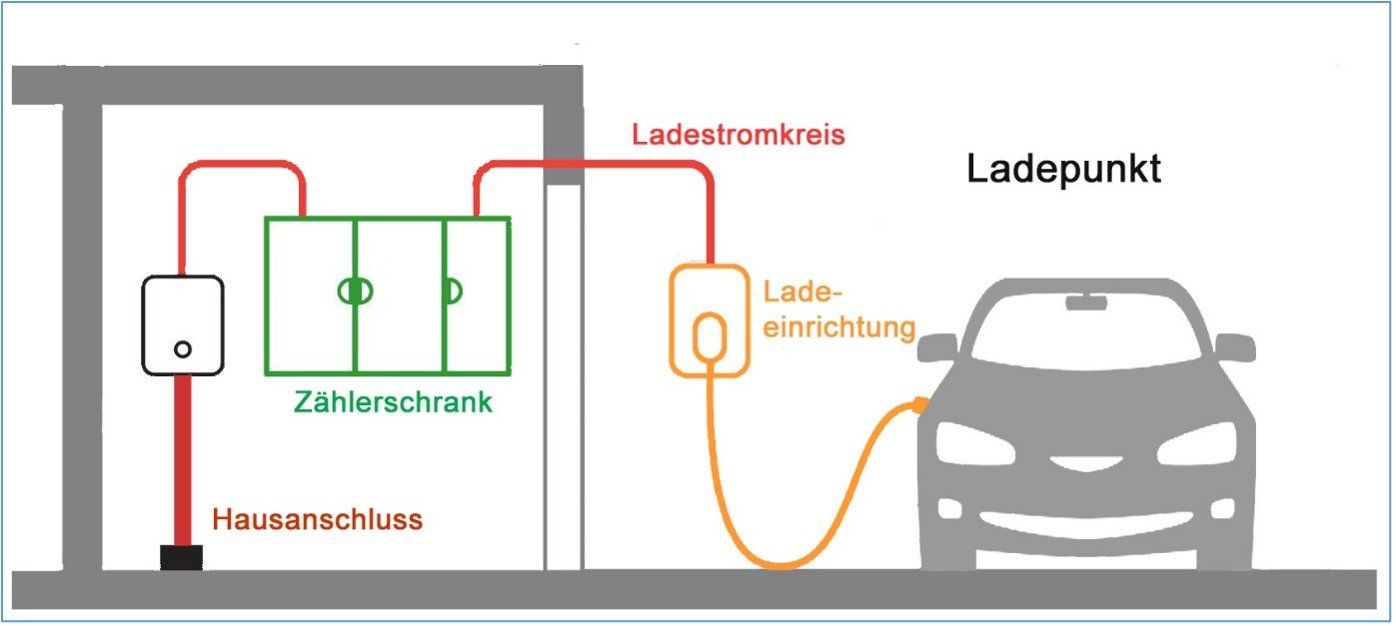
Figure 5: Basic design of the electrical installation for electric vehicle charging equipment.
Charging with AC current
When charging with an alternating current (AC charging), the electrical energy from the AC grid is firstly transferred to the vehicle using one or three phases. The charger installed in the vehicle takes care of rectification and controls the charging of the battery. In most cases, the vehicle is connected to the AC mains using a suitable power supply device such as an AC charging station or AC wall box.
Charging with DC current
Direct current charging (DC charging) requires that the vehicle connect to the charging station via a charging cable, whereby the charger is integrated in the charging station. Charging is controlled via a special communication interface between the vehicle and the charging station.
Inductive Charging
A common method of charging at present is grid-based charging, also known as conductive charging. With inductive charging, energy is transmitted using the transformer principle. This technology is still being developed and standardised for electric vehicles. For this reason, it is not yet commercially available on a large scale.
Normal charging and rapid charging
All charging processes with a capacity of up to 22 kW are considered normal. Charging processes with higher power loads are considered rapid chargers. In the future, fast and normal charging processes will tie in together more closely. Rapid charging with direct current (DC) is suitable for long-distance drivers throughout Germany, who can charge their electric cars without detours and waiting times. Normal charging with alternating current (AC) is primarily intended for locations where the customer stays longer [10].

Table 3: Charging speed and plug-in devices according to EU directive
Combined Charging System

Figure 6: The type 2 variant of the “Combined Charging System" according to IEC 62196-3 was defined by the European Commission in 2013 as a uniform standard for the whole of Europe
Charging modes
The plugs and couplings for charging electric vehicles are standardised throughout Europe. For example, the type 2 plug is used for normal charging with alternating current (AC). The Combo-2 connector (Combined Charging System - CCS) is used for rapid DC charging. The charging mode describes which charging cable and on which charging columns the electric vehicle can be charged. There are currently four charging modes specified in the IEC 61851-1 standard.
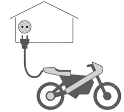
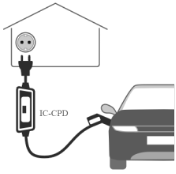
Charging mode 2 describes charging on a conventional protective contact socket or CEE socket up to a maximum of 32 A three-phase. This mode is characterised by the In Cable Control and Protection Device (IC-CPD). This IC-CPD is integrated in the charging cable and provides a safe power setting as a protection and control device. It also ensures the prescribed communication with the vehicle.
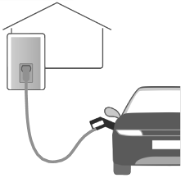
The current standard for AC charging columns according to IEC 61851 is charging mode 3. Charging takes place at a specially standardised charging socket, which is installed in a fixed charging station or wall box on the mains. There may also be a fixed charging cable at the charging point. The charging station contains all the necessary and safety-relevant components such as PWM, communication module, residual current circuit breaker or surge protection. In mode 3, up to a 63A three-phase charging current can be used. This allows a charging capacity of up to 43.5kW.
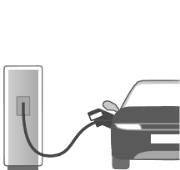
This charging mode describes DC charging on a fixed charging station. Due to the high safety requirements, the charger is not in the vehicle but is part of the charging column. The charging cable is also permanently connected to the charging station. In charging mode 4, the vehicle can be charged with two different plug-in systems: the “Combined Charging System (CCS) with a charging current of up to 200 A and a charging capacity of up to 170 kW and the Japanese-based CHAdeMO system with a lower charging capacity.
Table 4: Different charging modes
References:
- Wie umweltfreundlich sind Elektroautos? (How environmentally friendly are electric cars?), BMU 2021, Ifeu 2020.
- Lithium-Ion Vehicle Battery Production, Status 2019 on Energy Use, CO2 Emissions, Use of Metals, Products Environmental Footprint, and Recycling, IVL in cooperation with the Swedish Energy Agency.
- Sensitivity Analysis in the Life-Cycle Assessment of Electric vs. Combustion Engine Cars under Approximate Real-World Conditions, University of Applied Sciences, 2020.
- Comparison of Lifelong Greenhouse Gas Emissions by Electric Cars with Emissions from Vehicles with Petrol or Diesel Motors, TU Eindhoven, 2019.
- A Global Comparison of the Life-Cycle Greenhouse Gas Emissions of Combustion Engine and Electric Passenger Cars, Georg Bieker 2021 International Council on Clean Transportation, July 2021
- Extreme Weather Events in the Arctic and Beyond a Global State of Emergency, Global Climate Crisis Advisory Group (CCAG), July 2021
- https://www.europarl.europa.eu/news/de/headlines/society/20190313STO31218/co2-emissionen-von-autos-zahlen-und-fakten-infografik
- Agora Energiewende and Ember (2021): The European Power Sector in 2020: Up-to-Date Analysis on the Electricity Transition
- Technical Guide to Charging Infrastructure for Electromobility Version 3, BDEW, DKE,VDE FNN, DKE, 2020, https://www.vde.com/resource/blob/988408/ca81c83d2549a5e89a4f63bbd29e80c6/technischer-leitfaden-ladeinfrastruktur-elektromobilitaet---version-3-1-data.pdf
- BMVI website; Battery Electromobility Subsidy Programme https://www.bmvi.de/DE/Themen/Mobilitaet/Elektromobilitaet/Elektromobilitaet-kompakt/elektromobilitaet-kompakt.html
- The Building Electromobility Infrastructure Act (GEIG) https://www.dabonline.de/2021/05/21/geig-gebaeude-elektromobilitaetsinfrastruktur-gesetz-ladestationen-neubau-sanierung/









Head Office, Berlin,
Neue Grünstraße 17 | 18 Hof 1 | TRH 3
10179 Berlin
© ES EnviroSustain GmbH 2021




